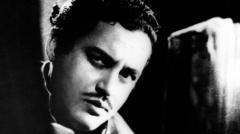What Made Guru Dutt a Tragic Genius of Indian Cinema?

The Life and Legacy of Guru Dutt: A Cinematic Journey Through Triumph and Tragedy
Guru Dutt, an iconic figure in Indian cinema, is remembered not only for his remarkable contributions as a director and actor but also for his tumultuous personal journey. Born on July 9, 1925, in Karnataka, Dutt's life was a blend of artistic brilliance and profound emotional struggles. Despite his premature death at the age of 39 in 1964, his films continue to resonate with audiences today, making him a celebrated figure in the annals of film history. This article delves into Dutt's extraordinary life, his cinematic achievements, and the personal demons that ultimately shaped his legacy.
Humble Beginnings: The Early Years of Guru Dutt
Guru Dutt's journey began in a modest household, where financial instability and family turmoil were constants. His family relocated to Bengal, a move that would significantly influence his artistic sensibilities. The rich cultural tapestry of Bengal ignited Dutt's passion for the arts, setting the stage for his future endeavors in the film industry.
After shifting to Bombay in the 1940s, Dutt entered the film industry not as a director but as a choreographer. He also took on various odd jobs, including that of a telephone operator, to support himself. The backdrop of India's struggle for independence added layers of complexity to his early career, as he grappled with his aspirations amid societal upheaval.
Crafting His Voice: The Birth of a Filmmaker
During this formative period, Dutt penned "Kashmakash," a narrative steeped in artistic frustration and social disillusionment, themes that would later permeate his magnum opus, "Pyaasa." His friendship with fellow actor Dev Anand proved pivotal; Anand's rise to fame opened doors for Dutt, allowing him to direct his first film, "Baazi," in 1951. This noir thriller showcased Dutt's unique storytelling style and marked his entry into the limelight.
Love and Success: The Rise of Guru Dutt
In his early career, Dutt experienced a whirlwind romance with celebrated singer Geeta Roy, which many accounts describe as one of his happiest periods. Dutt's burgeoning success in the film industry culminated in the establishment of his own production company, a significant milestone that set the stage for his future projects.
Back-to-Back Hits: Aar-Paar and Mr. & Mrs. 55
Dutt's romantic comedies, "Aar-Paar" and "Mr. & Mrs. 55," both featured him in lead roles and were well-received by audiences. However, driven by a desire for artistic depth, Dutt soon embarked on a journey to create what many would consider his defining work—"Pyaasa." This film explored the struggles of an artist in a materialistic world and resonated with audiences on a profound emotional level.
The Masterpiece: Pyaasa
Released in 1957, "Pyaasa" was a critical and commercial triumph, solidifying Dutt's status as a visionary filmmaker. The film's exploration of themes such as love, despair, and the search for meaning struck a chord with audiences, leading to its inclusion in Time magazine's list of the 100 greatest movies of the 20th century. Dutt's sister, Lalitha Lajmi, emphasized that "Pyaasa" was her brother's "dream project," and he was determined to perfect it.
The Creative Process: Perfectionism and Turmoil
As a director, Dutt was known for his hands-on approach to filmmaking. He often made extensive changes to scripts and experimented with camera techniques, leading to a high level of stress on set. His quest for perfection, especially during "Pyaasa," manifested in extreme measures; he reportedly shot 104 takes of the film's climax, indicative of his obsessive pursuit of artistic excellence.
Struggles Beneath the Surface: Mental Health and Personal Crisis
Despite his professional success, Dutt's personal life was marked by turmoil. His struggle with mental health issues began to surface during the production of "Pyaasa," culminating in a suicide attempt in 1956. His family, unable to confront the deep-seated issues he faced, neglected to seek professional help, reflecting the stigma surrounding mental health in that era.
Released to critical acclaim, "Pyaasa" did not alleviate Dutt's feelings of emptiness. He expressed a haunting realization—having achieved his goals, he still felt a void within. His cinematographer, VK Murthy, recalled Dutt's poignant reflection: "I wanted to be a director, an actor, make good films—I have achieved it all. I have money, I have everything, yet I have nothing."
Contradictions and Paradoxes
The paradox of Dutt's life was stark; while his films portrayed strong, independent women, his personal expectations of his wife were steeped in traditionalism. This dichotomy echoed throughout his life, capturing the essence of a man torn between his artistic vision and societal expectations.
Kaagaz Ke Phool: A Semi-Autobiographical Journey
Emboldened by the success of "Pyaasa," Dutt ventured into creating his most personal and ambitious project, "Kaagaz Ke Phool." This semi-autobiographical film explored the complexities of a filmmaker's life, including themes of love, despair, and artistic integrity. Although now regarded as a classic, it was a commercial failure at the time, a blow that Dutt reportedly never fully recovered from.
The Impact of Failure
The aftermath of "Kaagaz Ke Phool" marked a turning point in Dutt's career. He never directed another film again, and the weight of his failures weighed heavily on him. Despite this, his production company continued to thrive, leading to the successful release of "Chaudhvin Ka Chand," the highest-grossing film of his career.
Personal Turmoil: A Deepening Crisis
As Dutt's professional life flourished, his personal life unraveled. His marriage faced insurmountable challenges, culminating in separation. Struggling with profound loneliness and mental health issues, Dutt turned to alcohol and sleeping pills for solace. His emotional state deteriorated further, marked by mood swings and bouts of despair.
Attempts at Help and Continued Struggles
After a near-fatal suicide attempt, Dutt’s family briefly consulted a psychiatrist, yet they failed to pursue ongoing treatment. Lajmi expressed regret over this missed opportunity, believing her brother was silently pleading for help amid his deepening despair. Even after his discharge, the routine of shooting films resumed as if nothing had happened, highlighting the disconnect between Dutt's public persona and his internal struggles.
Tragic End: The Death of Guru Dutt
On October 10, 1964, Guru Dutt was found dead in his room at the age of 39. His death was a tragic culmination of the struggles he faced throughout his life, a poignant reflection of the themes he so often explored in his films. Co-star Waheeda Rehman poignantly noted that Dutt longed for death, perhaps finding solace in the very escape that ultimately claimed him.
A Legacy Beyond Life
Guru Dutt's profound impact on Indian cinema is undeniable. His unique ability to weave personal experiences into his films created a rich tapestry of storytelling that continues to inspire filmmakers and audiences alike. While he may not have lived to see the full extent of his legacy, his contributions to cinema have left an indelible mark on the industry.
Conclusion: Reflecting on Guru Dutt’s Life and Work
Guru Dutt's life serves as a reminder of the complex interplay between personal struggles and artistic expression. His films continue to resonate with audiences, serving as a testament to his talent and a reflection of his internal battles. As we celebrate the centenary of his birth, we are reminded of the importance of mental health and the need for open conversations surrounding it in the creative industry.
As we reflect on Dutt's legacy, one must wonder: What might have been if he had received the help he needed? How many more masterpieces would he have created? In the end, Guru Dutt remains a poignant figure in cinema—a symbol of artistic brilliance intertwined with personal turmoil.
FAQs
What inspired Guru Dutt's filmmaking style?
Guru Dutt's filmmaking was largely influenced by his personal experiences and the socio-political environment of post-independence India. His films often explored themes of love, despair, and social issues, resonating with audiences on a deep emotional level.
What are some of Guru Dutt's most notable films?
Some of Guru Dutt's most acclaimed films include "Pyaasa," "Kaagaz Ke Phool," "Aar-Paar," and "Sahib Bibi Aur Ghulam." Each film showcases his unique storytelling approach and deep understanding of complex human emotions.
How did Guru Dutt's personal struggles affect his career?
Guru Dutt's personal struggles with mental health significantly impacted his career. His emotional turmoil often influenced his creative process, leading to both brilliant films and tragic outcomes, including his untimely death.
As we ponder the life and legacy of Guru Dutt, it serves us to remember the importance of mental well-being, especially in the high-pressure world of creativity. His story encourages us to look beyond the surface and to seek understanding and empathy in the lives of those around us. #GuruDutt #IndianCinema #MentalHealthAwareness
Published: 2025-07-06 00:16:29 | Category: world



